Reindeer Games: Tracking Caribou in the Slate Islands

'A caribou approaching the author's campsite.'
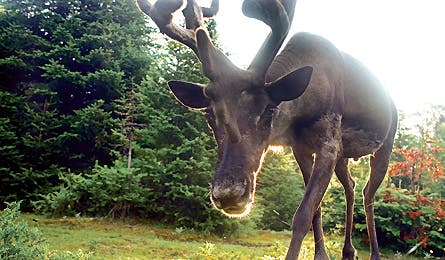
A caribou approaching the author’s campsite.
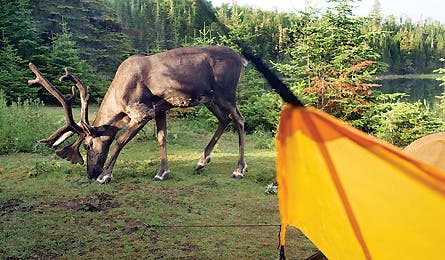
A bull grazing in Fisherman’s Cove.
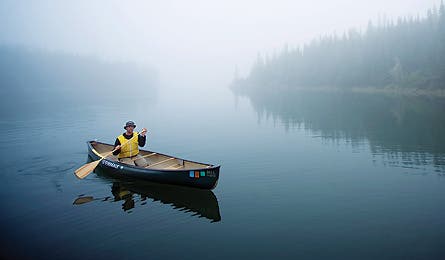
The author paddling through the fog.
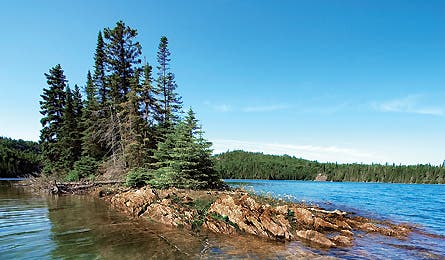
A rock formation in Lake Superior.
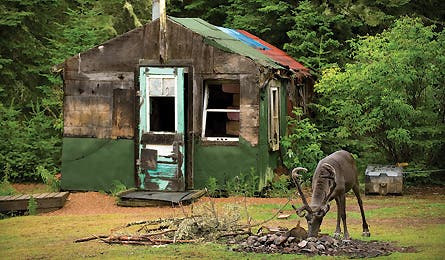
A woodland caribou scarfs ashes.
Caribou shouldn’t live on the Slate Islands. Truth be told, the Slates themselves, eight miles off the Canadian coast in Lake Superior, shouldn’t even exist.
A billion years ago, a meteorite smashed into Earth, pushing Precambrian bedrock like snow in front of a plow. The result, say geologists, is this archipelago of a dozen rocky, forested islands. Fast forward to the fiercely cold winter of 1907: Superior’s waters froze solid (which happens only a couple of times a century), and the lighthouse keeper on the Slates’ Patterson Island saw seven sets of cloven tracks leading from the mainland. The caribou had arrived.
Over the next hundred years, logging and forest destruction drove mainland caribou herds north. Their range receded more than 200 miles from Superior’s shores to Lake Nipigon in Ontario. But caribou on the Slate Islands flourished, with the original pioneers growing to a herd of 600 by the 1980s. Over the decades, the population has boom-and-busted, and today 200 woodland caribou roam these Northwoods isles–the world’s densest population.
Even so, photographer Layne Kennedy isn’t convinced we’ll see any. He’s kayaked here twice before and only saw a caribou once–briefly, and only a rump. This is disquieting news, since we’re enduring a chilly summer sea spray whipping off the bow of a Cruiser motorboat that’s ferrying us and my canoe across the channel from Terrace Bay, Ontario, to Slate Islands Provincial Park. Our mission: To see lots and lots of caribou.
I’ve been enamored with the idea of walking among caribou since childhood, when I first saw that epic scene in Never Cry Wolf where Charles Martin Smith runs among a rumbling herd. I was only nine years old, but the symbolism stuck: The caribou would forever be my supreme icon of high wilderness, remote backcountry, and pure adventure. Twenty years later, I backpacked in Denali hoping to see some caribou–and got skunked. A drought had pushed them all high into the mountains. I saw grizzlies, but my heart ached for antlers.
“Don’t worry about it, eh? You’ll see ’em,” reassures Tom Falzetta, captain of our boat and sole operator of Slate Islands Charters. “You were just in the wrong spot, eh?” he says to Layne, and then announces that he’ll drop us in a caribou hot zone. “Everybody I’ve taken out here has seen ’em. In fact, most people end up moving their camp because the caribou come out at night and trip over all of their stuff.”
Falzetta drops us at McGreevy Harbour on Patterson Island, the largest of the Slates, at the edge of a balsam fir and paper birch forest. The Ontario Ministry of Natural Resources took possession of the islands and designated them a provincial park in 1985. With our Crown Land Camping Permit, we’re free to pitch tents anywhere we please on Patterson Island’s 12 square miles or on any of the other four smaller islands in the park’s interior. Falzetta tells us most folks camp near one of the five deserted cabins scattered about the Slates, since those are open areas with fire pits and outhouses.
We unload our gear as Falzetta throttles his boat and shouts back a few words of encouragement: “Don’t worry. By the end of the week, the caribou will be pissing you off!”
Layne and I sink tent stakes into grass grazed to the nub. It looks like a putting green. We think about hanging our food bag, but there aren’t any black bears here; aside from caribou, the only significant mammal populations on the Slates are snowshoe hare, red fox, and beaver. After setting up camp, we hop into my canoe for some on-the-water relief from the blazing July afternoon.
Fishing lines trail in our wake as we troll spoons for lake trout. Paddling on calm water between islands, sheltered from Superior’s swells, I hear the drip-drip of water falling from my wooden blade, the croaaawnk of ravens gliding overhead, the reverberating yodels of loons, and the wind gushing through the tops of Northwoods conifers. Think Boundary Waters with a caribou sanctuary in the middle.
We enjoy the idyllic canoeing, but I don’t forget that Lake Superior is really a small inland sea. Water temperatures are always hypothermic–rarely above 50°F even in summer. And whitecaps can whip up in an instant, turning a leisurely paddle into a wild horse race. I hug the shore and keep an eye on the billowing clouds.
We land the canoe more than a mile southwest from camp at Jacks Bay, where the ruins of a logging barge, now a heap of timbers and half-sunk metal, give a foreboding air to the inlet. Back in the 1930s, when the Slates were logged, this barge ran aground during a shipping run and was abandoned. Snowshoe hares scatter as we step onto land. The grass here is grazed to a stubble, too–more signs of caribou. But after an hour of wandering around the barge site and a lunch of Clif Bars and bison jerky, we see none and head back to the canoe.
Later, at dusk, as Layne rests by the campfire, the glassy waters draw me back, and I return to Jacks Bay on a solo paddle. It’s hard to see much with evening descending, but among the boulders on shore I spy something: the stubby tail of a caribou. With short, surreptitious paddle strokes, I inch closer. Then…kerplunk! A beaver whacks his tail on the water. I see the caribou’s head rise and watch its shadow disappear into the firs. The ghost vanishes.
Distant thunderclaps wake us on day two, and the water is roiling. There will be no paddling today. Before the rain comes, I grab my fishing pole and hike along the cobbled shore a quarter-mile west from camp to cast off the point of the bay. When I return, Layne greets me with crazed eyes and exaggerated arm motions.
“You missed it!” he points. “There was a huge bull right here!”
I ask which way the caribou went, then bushwhack into a curtain of balsam. An hour later, I step out onto an enormous shoreline boulder and see tumultuous, ocean-size waves pounding the Slates’ outer islands. I’ve reached the eastern side of Patterson. A rain column moves overhead, and a serious drenching ensues. I tug on raingear and trudge back to camp.
My only consolation? Caribou paths make for great hiking. There are no official trails on the island, but caribou have trod well-developed, brush-free thoroughfares that spiderweb across the interior. Head down, I follow the moving triangle on my GPS, spotting hoof prints all the way back to the outskirts of our camp. That’s when I hear the muffled thump of cloven hooves on tree roots. I peer through the dim forest of evergreen boles and branches thickly strewn with threads of chartreuse usnea lichens–or Old Man’s Beard–strung like tinsel on a Christmas tree. I squint to see a silhouette pausing between two trees. The dark head swivels. I move, and it’s gone.
Back in camp, I duck for cover beneath a big balsam with wide branches. I’m soaked, sweaty, chilled. I have no desire to crawl into my skinny solo tent, so for what seems like hours I lean on the tree, staring at the rain beading off my boot’s leather.
Then the sun brightens the sky–and my foul mood. Layne and I string up our clothes to dry, boil water for hot apple cider, and eat a chocolate bar and gorp. We talk about heading out in the canoe. Then the ghost reappears.
Silently, a bull caribou–as gray as dusk–strides between our two tents. We stop talking mid-sentence and gawk. The caribou marches with an audacious elegance: hooves high-stepping, nose and enormous velvet-covered antlers held aloft. Sinew ripples through his body with each step, like a thoroughbred.
Then, inexplicably, the caribou stops at our fire pit, lowers his head, and voraciously eats the ashes. Nosing aside still-smoldering logs, he scarfs the entire bed while Layne and I watch in disbelief. Then the bull, smaller than a moose but bigger than a white-tailed buck, looks up and stares at us with wide, wild eyes. He turns, and with four giant bounds, covers 30 yards and vanishes into the balsams.
Late that night, I awaken to the sound of teeth powerfully munching grass. The caribou is back. He passes my tent and nicks the guyline with his leg–thwinnng!–like a fiddle string.
Morning brings more caribou, a lesser bull and a few cows browsing our fire pit, now stocked with fresh ashes from a breakfast campfire. The group pays little attention to us. It’s not that the Slates’ caribou are accustomed to people, but with no hunting and after 100 years without natural predators, they seem to have forgotten fear.
Oddly, the biggest threat to Slates’ caribou are unintentional, yet self-inflicted, hangings. They crane their necks for high-hanging lichens, in a desperate search for winter food, and they become entangled in branches or tree crotches and can’t escape. Hundreds strangled themselves in the bitter cold of 1996.
To learn more about the lives of Slates’ caribou, Layne and I rendezvous at Jacks Bay on day three with a team of five biologists who study the herd. Team leader Steve Kingston is a 30-something, red-haired ecologist who looks like a young Robert Redford. He’s here to check vegetation exclosures–areas excluded from caribou grazing by fencing. These allow researchers to compare the luscious forest floor inside with the heavily grazed ground outside. The study tackles a popular hypothesis for why the Slates’ caribou population booms and busts.
“Our question is: Do the caribou eat themselves out of house and home, or is it something else?” he explains.
Kingston’s research will inform a provincial recovery plan for woodland caribou, listed as a threatened species by the Ontario Ministry of Natural Resources. The plan identifies five caribou recovery zones, including one along the Lake Superior coast that may be stocked with animals relocated from the Slate herd.
The researchers camp nearby, and over wine I ask one final question. “Why in the world did that caribou eat the ashes from our fire pit?”
“Salt?” offers one of the biologists. “Potassium?” says another. “Potash?” “Digestive aid?” Each scientist has a different theory. But they all agree: Mainland caribou don’t eat campfire ashes, so the Slate caribou must have adapted that trait on their own.
Back at camp, we commemorate our final evening with fresh-caught lake trout, chocolate bars, hot tea, and a warm fire. Just as I toast our resounding success of 20 caribou sightings, the smoke summons the bull for one last encounter. He materializes from the dark to stomp out the smoldering embers, gobble up the ashes like a kid going at a plate of mac n’ cheese, and kick in the rocks of our fire ring for good measure. It’s bizarre, but now oddly routine.
Plan It
Ontario’s Slate Islands
The Way
Access the Slates from the public dock at the mouth of the Aguasabon River in the town of Terrace Bay along King’s Highway 17, 500 miles from Minneapolis-St. Paul or 650 miles from Detroit. Paddle (or take a ferry) the final eight miles of open water on Lake Superior.
When to go
July and August are optimal–after the bugs thin out but before the ferocious fall stormy season. But even in summer, Lake Superior has a reputation for nasty, mercurial weather, so build an extra day into your itinerary and bring extra food.
Gear
Pack bomber raingear (a downpour is all but guaranteed during a weeklong stay), plus a winter hat, gloves, and baselayers (it has snowed here in July).
Maps and Permit
Request a map when you call the park office (807-825-3403) to purchase your required Crown Land Camping Permit ($10/night Canadian).
Ferry Slate Islands Charters, (807) 825-9333. Captain Tom Falzetta can tell you where the caribou have been most active.
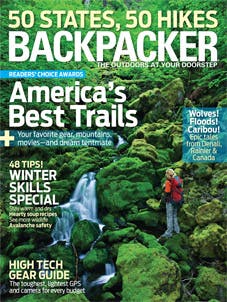
Caribou Conservation
Read how the Slate Island Caribou fit into the Ontario Ministry of Natural Resources’ massive mainland recovery plan at mnr.gov.on.ca/en/Business/Species/2ColumnSubPage/249504.html.